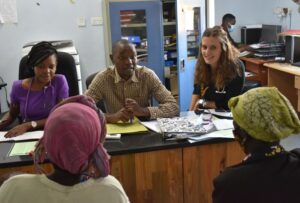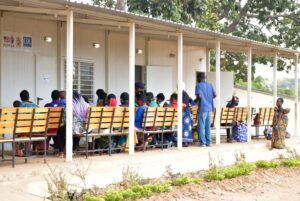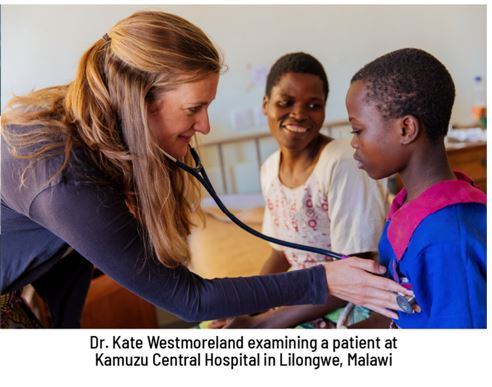Pediatric Cancer
Ongoing and Upcoming Studies
Understanding Methotrexate Dosing, Pharmacokinetics, and Toxicities for Burkitt Lymphoma in Malawi
Summary
(PI, Dr. Katherine Westmoreland)
Background:

More than 80% of childhood cancers occur in low- and middle-income countries (LMIC) where survival is poor for cancers that are typically cured in high-income countries. In sub-Saharan Africa (SSA), Burkitt lymphoma (BL) is the commonest pediatric malignancy, but overall survival (OS) is only 30-60%, compared with >90% in high-income countries. Chemotherapy must be administered cautiously due to limited supportive care, erratic blood product availability, few trained oncology staff, weak infrastructure, and high infectious burden. While efforts are ongoing to build cancer care capacity in SSA, it is widely understood that chemotherapy regimens from high-income countries must be tailored to SSA settings to improve patient outcomes. We have previously demonstrated suboptimal BL outcomes in Malawi, despite moderate-intensity anthracycline-based treatment. In Malawi, most deaths are due to progressive BL, not chemotherapy toxicity. This suggests that better chemotherapy approaches are urgently needed, particularly as there is no widely accepted standard of care for treating children and adolescents with BL in SSA.

High-dose methotrexate (MTX) is a key component of BL treatment in resource-rich settings. While high-dose MTX has been used at some SSA sites, others have reported unacceptable toxicity. Remarkably, although it is a pillar of effective BL treatment worldwide, there has never been a prospective clinical trial in SSA evaluating high-dose MTX for BL with rigorous monitoring as is routine in high-income countries, including MTX levels and comprehensive toxicity assessments.
Goals:

The main goals are to improve the understanding of chemotherapy pharmacokinetics (PK) and patient-reported health-related quality of life outcomes in pediatric and adolescent Burkitt Lymphoma patients, integrated within a rigorously conducted prospective clinical trial, to optimize treatment regimens and improve survival.
Aims:
- To determine the toxicity and outcomes for children and adolescents with moderate and high-risk BL in Malawi.
- To develop a population pharmacokinetic (PK) model for children and adolescents receiving high-dose MTX for BL in Malawi
- Translate, culturally validate, and implement the patient-reported outcomes (PRO)-CTCAE assessment tool to measure treatment-related toxicity in Malawi
Overview:
Funding Agency: K-01, NIH (NCI/Fogarty)
First Screening: Anticipated March 2022
Target accrual: 200 (observational cohort), 60 (PK sub-study)
Validation and administration of a new tablet-based voice-enabled application to measure patient-reported outcomes (PROs) among low-literacy pediatric and adolescent hematology-oncology patients in Malawi
Brief Background:
This will be the first-ever tablet-based voice-enabled application to administer the PROMIS and PRO-CTCAE pediatric instruments in a low-literacy patient population. This will allow the implementation truly patient-reported cutting-edge PRO measures in Malawi, to holistically and comprehensively assess symptomatic adverse events and HRQoL, similar to ongoing efforts in resource-rich countries. This is an essential development to give this vulnerable patient population a voice and allow them equal access to PRO measures, which have been proven to improve symptom control, patient satisfaction, and clinical outcomes. Furthermore, we believe that direct reporting of Pediatric PRO-CTCAE to measure symptomatic adverse events will lead to more complete and accurate toxicity assessments allowing us to better care for our patients and monitor clinical trial safety.
Aims:
1. To validate the mode of administration (interviewer vs. voice-enabled tablet) for direct PRO measures among 50 low-literacy pediatric and adolescent hematology and oncology patients in Malawi.
2. To administer the Peds PROMIS-25 and PRO-CTCAE. Questionnaire via the voice-enabled tablet in a cohort of 500 pediatric hematology (n=250) and oncology (n=250) patients in Malawi to measure changes in HRQoL and symptomatic adverse events, longitudinally over time. (Phase 2)
Overview:
Study PI: Dr. Kate Westmoreland
Funding Agency: NIH (NCI/Fogarty/NIAID/NHLBI)
First Screening: Anticipated June 2022
Target accrual: Mode of administration validation (50); implementation (500)
Pediatric HIV/AIDS & Infection-Related Malignancies Research Consortium for sub-Saharan Africa (PARCA)
Brief Background:
The goal of this proposal is to establish PARCA, a collaborative clinical and translational research framework designed with the overarching goal to improve the current unacceptably poor outcomes of children with HIV-associated malignancies in sub-Saharan Africa (SSA).
Currently, over 80% of children with cancer in the US survive, whereas over 80% in the majority of SSA
countries die. To begin to address this disparity and improve outcomes for children with cancer in SSA, Texas Children’s Hospital leveraged the clinical infrastructure of BIPAI in Uganda, Malawi, and Botswana to establish Global HOPE (Hematology-Oncology Pediatric Excellence). Global HOPE is dedicated to excellence in the care and treatment of children globally with cancer and blood disorders through state-of-the-art treatments and cutting-edge research. These three Global HOPE pediatric cancer programs, which treat patients nationwide, have begun to transform cancer care in SSA. For example, Global HOPE sites in Uganda and Malawi each diagnose and treat approximately 400 new cases of childhood cancer annually. In regard to patient volume, these pediatric cancer programs rival some of the largest children’s hospitals in the US.
In the US, improvements in pediatric cancer survival were achieved largely through clinical and translational research coordinated by cooperative groups such as the Children’s Oncology Group. Following that model, we propose to establish a framework for collaboration to enable advances for children in SSA living with HIV and diagnosed with cancer through the Pediatric HIV/AIDS & Infection-Related Malignancies Research Consortium for Sub-Saharan Africa (PARCA).
The Central Research Theme for PARCA will be improving outcomes for children with HIV-associated
malignancies, with a focus on infection-related cancers, such as Kaposi sarcoma and lymphoma. PARCA will comprise three research projects investigating the epidemiology of these cancers across SSA (Project 1), improving diagnosis of pediatric cancers (Project 2), and developing risk-adapted treatment (Project 3) of HIV associated malignancies in SSA. PARCA will be supported by four cores: Administrative, Developmental, Diagnostics & Laboratory, and Biostatistics & Clinical Research.
Aims:
Major Goals: 1) Define the descriptive epidemiology and infectious exposures related to pediatric malignancies in SSA; 2) Conduct transformative inter-disciplinary collaborative research to reduce the burden of KS and lymphoma among children and adolescents in SSA; 3) Support the formation of a multi-national collaborative resource in clinical and translational research, training, and career development for African scientific leaders in HIV and pediatric cancer.
Overview:
Study PI: UNC Site PI: Dr. Kate Westmoreland (Parent award is at Baylor College of Medicine)
Funding Agency: U54, NIH (NCI)
First Screening: January 2022
Target accrual: 300 Pediatric Burkitt Lymphoma Patients, 100 Kaposi Sarcoma Patients
Road to HIV and Sickle Cell Disease Gene-based Cures in sub-Saharan Africa: A Preparatory Pilot in Lilongwe, Malawi
Background:
Sickle Cell Disease (SCD) is one of the most common inherited hematologic diseases in the world. Because no country in SSA has adopted a national newborn screening program, the precise burden of SCD in Africa is unknown, but it is estimated that approximately 300,000 infants are born annually with SCD in SSA. SCD is a chronic hemolytic anemia that damages almost every organ in the body. Without diagnosis and proper care, 50-90% of children with SCD in Africa will die before 5-years of age, contributing to 5-16% of under 5 mortality in SSA. In 2017, the Malawi Sickle Surveillance Study (MS3), a partnership between UNC Project-Malawi and Cincinnati Children’s Hospital (CCH), conducted large scale testing of over 10,000 dried blood spots from HIV-exposed infants born in the central region. MS3 demonstrated that the birth prevalence of sickle cell trait was 7-10%, and that approximately 2,000 infants are born with SCD nationwide annually, similar to the annual incidence of pediatric HIV infection, yet the efforts to support children with SCD are decades behind those of HIV in Malawi.
The HIV clinical trials research infrastructure in Malawi is sophisticated and mature, illustrated by UNC Project-Malawi currently enrolling patients on protocols from all five of the NIH HIV networks (HPTN, ACTG, IMPAACT, MTN and VTN). However, some gaps must be filled before Malawi is prepared to conduct HIV cure research. SCD infrastructure lags even further behind. In 2010, the WHO Regional Office for Africa outlined a detailed plan for developing national SCD programs that include early detection, treatment, surveillance, research, and community education. The “NOHARM” (Opoka 2017) and “REACH” (Tshilolo 2019) trials recently demonstrated that oral hydroxyurea was safe for children in SSA and decreases SCD morbidity and mortality. SCD surveillance, research, and community education must be expanded and advanced in SSA to reduce preventable deaths and to provide the robust infrastructure required to test curative strategies. This proposal plans to initiate those efforts in Malawi, leveraging existing partnerships to improve SCD care at all levels.
Aims:
Overall Goal: Preparation and capacity building in Malawi so that when effective, durable, safe, and accessible gene-based cures for both sickle cell disease (SCD) and HIV infection are developed, they can be scaled and implemented in sub-Saharan Africa (SSA).
Objectives:
To develop the ability to conduct clinical trials of gene-based cure for SCD and HIV in Malawi through capacity building focusing on the following objectives:
- Increase SCD-specific diagnostic capacity
- Optimize all aspects of multi-disciplinary SCD clinical care including case finding, outpatient preventive and disease-modifying therapy, inpatient acute care, education of patients and providers, and ancillary support services
- Develop and implement an SCD-specific electronic database
- Establish a robust SCD and HIV research infrastructure
- Explore the ethics of and community preparedness for gene-based SCD and HIV curative therapy
- Improve communication, collaboration, and data management
Overview:
Study PI: Dr. Kate Westmoreland
Funding Agency: CFAR Supplement Award, NIH (NHLBI,NIAID)
Status: Pending IRB approval for multiple small pilot studies